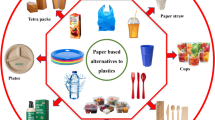Abstract
The use of starch and hydrolytic enzymes as replacement for traditional polishing pigments (e.g., Cu2O and ZnO) in antifouling coatings has been investigated. The enzymes facilitate a slow conversion of water-insoluble starch into water-soluble glucose, and dissolution of glucose causes the development of a leached (porous) layer in the wetted, outermost part of the coating. Subsequent water–binder interaction at the pore walls gives rise to polishing, in a manner similar to that of conventional antifouling coatings. Different starch types have been evaluated and classified as potential coating ingredients, and the impact of the addition of starch on the functional properties of the coating is described. Starches from rice, corn, and tapioca have been tested, and due to a smaller amount of water-soluble content and lesser tendency to agglomerate, corn starch is preferred. Leaching occurs in all the starch-enzyme coatings tested; however, polishing is only detected for two out of four binder systems investigated. Suitable polishing rates of 7–10 μm/month, based on the enzymatic starch-degradation, have been measured. Controls containing only starch (no enzyme) did not polish.









Similar content being viewed by others
Abbreviations
- Ci:
-
Starch type number i originating from corn
- C s :
-
Seawater solubility (mol/m3)
- M :
-
Molar mass (kg/mol)
- Ri:
-
Starch type number i originating from rice
- T:
-
Starch type originating from tapioca
- α:
-
Seawater solubility (dimensionless)
- ρ:
-
Density (kg/m3)
- CPVC:
-
Critical pigment volume concentration (vol%)
- DFT:
-
Dry film thickness (μm)
- LLT:
-
Leached layer thickness (μm)
- OA:
-
Oil absorption
- PSD:
-
Particle size distribution
- PVC:
-
Pigment volume concentration (vol%)
References
Yebra, D M, Kiil, S, Dam-Johansen, K. “Review: Antifouling Technology—Past, Present and Future Steps Towards Efficient and Environmentally Friendly Antifouling Coatings.” Prog. Org. Coat. 50, 75-104 (2004).
Yebra, D M, Kiil, S, Weinell, C E, Dam-Johansen K, “Mathematical Modeling of Tin-Free Chemically Active Antifouling Paint Behaviour.” AlChE 52 (5), 1926-1940 (2006).
Giudice, C A, del Amo, B, Rascio, V J D, Sindoni,O, “Composition and Dissolution Rate of Antifouling Paint Binders (Soluble Type) During Their Immersion in Artificial Sea Water.” J. Coat. Technol. 58 (733), 45-50 (1968).
Kiil, S, Dam-Johansen, K, Weinell, K, Pedersen, M, S, “Analysis of Self-Polishing Antifouling Paints Using Rotary Experiments and Mathematical Modelling.” Ind. Eng. Chem. 40, p 3906 - 3920 (2001). doi:10.1021/ie010242n.
Kiil, S, Dam-Johansen, K, Weinell, C E, Pedersen, M S, “Seawater-Soluble Pigments and Their Potential Use in Self-Polishing Antifouling Paints: Simulation Based Screening Tool.” Prog. Org. Coat. 45, 423-434 (2002).
Kiil, S, Weinell, CE, Pedersen, MS, Dam-Johansen, K. “Mathematical Modelling of Self-Polishing Antifouling Paint Exposed to Seawater: A Parameter Study.” IChemE. 2002. 80, 45 - 52 (2002).
Somasekharan, KN, Ubrammanian, RV, “Structure, Mechanism and Reactivity of Organotin Carboxylate Polymers.” ACS Symp. Ser. 121, 165-181 (1980).
Olsen, SM, Pedersen, LT, Kiil, S, Kristensen, JB, “Developing Enzyme-Based Antifouling Coatings Part II: The Coating System.” Oral presentation at the 14th International Congress on Marine Corrosion and Fouling. Kobe (2008)
Dunn-Coleman, N, Neefe-Kruithof, P, Pilgrim, CE, Ward, DE, van Solingen, P, “trichoderma Reesei Glucoamylase and Homologs Thereof.” United States Patent Application Publication. Pub. no. US2006/0094080A1 (2006)
Sauer J, Sigurskjold BW, Christensen U, Frandsen TP, Mirgorodskaya E, Harrison M, Roepstorff P, Svensson B.: “Review Glucoamylase: Structure/Function Relationships, and Protein Engineering”. Biochim. Biophys. Acta 1543, 275-293 (2000).
Yebra, D M, Kiil, S, Weinell, C E, Dam-Johansen, K, “Dissolution Rate Measurements of Sea Water Soluble Pigments for Antifouling Paints: ZnO”. Prog. Org. Coat. 56, 327-337 (2006).
Oates C G, “Towards an Understanding of Starch Granule Structure and Hydrolysis.” Trends Food Sci. Technol. 8, 375-382 (1997) doi:10.1016/S0924-2244(97)01090-X.
Acknowledgments
This work was funded by the Danish Ministry of Science, it is part of the CHEC Research Center funded a.o. by the Technical University of Denmark, the Danish Technical Research Council, the European Union, the Nordic Energy Research, Dong Energy A/S, Vattenfall A.B., F L Smidth A/S, J.C. Hempel’s Foundation, and Public Service Obligation funds from Energinet.dk and the Danish Energy Research program.
Author information
Authors and Affiliations
Corresponding author
Rights and permissions
About this article
Cite this article
Olsen, S.M., Pedersen, L.T., Dam-Johansen, K. et al. Replacement of traditional seawater-soluble pigments by starch and hydrolytic enzymes in polishing antifouling coatings. J Coat Technol Res 7, 355–363 (2010). https://doi.org/10.1007/s11998-009-9191-3
Published:
Issue Date:
DOI: https://doi.org/10.1007/s11998-009-9191-3




